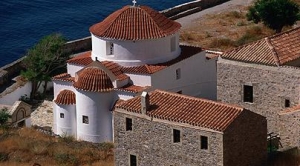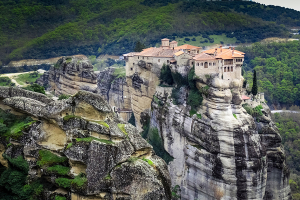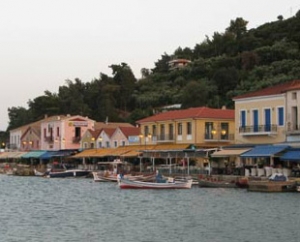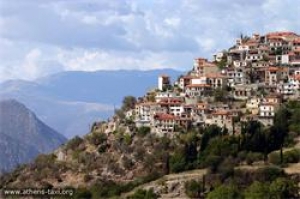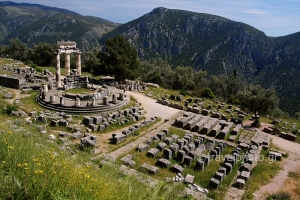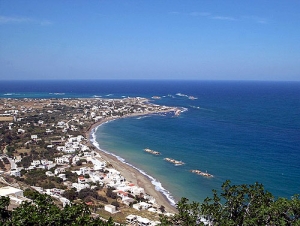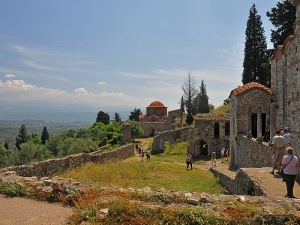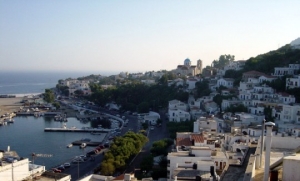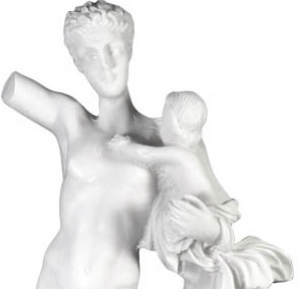Delphi is one of the most important archaeological sites of Greece. Accordingly, it is featured in the itinerary of every traveler who is attracted to the oracle that influenced affairs around the Mediterranean for over a thousand years. It was a place of immense religious and political influence in ancient times, prompting private people as well as governments from Greece and abroad to seek it's consultation before undertaking any major personal or public initiatives.
Today, it is a well preserved and respected archaeological site that affords splendid views of both the cultural and physical landscapes of Greece.
History
Archaeologist have found evidence that the site of Delphi was inhabited as far back as the Neolithic era, and that by the end of the Mycenaean period (1600-1100 BCE) it had become an important religious and political center of influence. While the function of the oracle during prehistory is obscured by the lack of records, the importance of Delphi during historical times is well documented by a plethora of ancient writers and the rich archeological finds of the site.
Delphi was considered by the ancients to be the center (Omphalos = navel) of the world, and the oracle of Delphi was a religious center, most famous for its accurate predictions of the future. The oracles were given by Pythia, the priestess who muttered incomprehensible sounds in a state of trance, which in turn were translated in comprehensible language and give to those who made the pilgrimage in search of answers.
Common folk, generals, and kings alike, consulted the oracle of Delphi on matters of importance. Matters of importance ranged from mundane every-day family disputes, to the decision of a state to go to war with another, or to establish a colony. The reputation of Delphi crossed cultural boundaries, and throughout history it held amicable neutrality with its oracles. At the same time, the oracles of Pythia were notoriously ambiguous, and could be interpreted several different ways.
The sanctuary of Delphi spans with its influence the entire gamut of ancient Greek history as we know it. During the Mycenaean era between 1600 and 1100 BCE, Delphi was a place of worship of the Mother Earth deity (Ge), before it was converted to the place of worship of Apollo as the god of light, harmony and order at the end of the 11th c. BCE. Its influence grew over the next few centuries, and by the 8th c. BCE the oracle of Delphi had acquired international fame for its accurate predictions of the future.
Throughout ancient times entire communities placed their fate in the words of Pythia, and endless emissaries and worshipers flocked to the sanctuary with gifts and offerings in hoping for a favorable oracle. As a result, the sanctuary was teeming with valuable goods, and affluent states built and maintained elaborate treasuries to shelter the wealth. The treasuries of the Athenians and the one dedicated by the Syphnians are still well preserved on the site, and admired for their beautiful sculptural decoration.
The Pythian Games
As a place of pilgrimage, Delphi evolved to be hosting a conglomerate of cultural activities, ranging from poetry reading and theatrical plays, to athletic events similar to the Olympics, called the Pythian Games.
The Pythian Games took place every four years to honor Apollo, and hosted poetry and music competitions besides the staple of athletic events. It is believed that the games were first organized sometime in the 11th c. BCE, and included only musical contests, but by the 6th c. BCE, the games grew to include athletic events. The games ceased to take place in the 4th c. CE, but there was a small revival in the beginning of the 20th c. CE, when the Greek poet Angelos Sikelianos organized the Pythian games at Delphi once again.
The sanctuary remained an important place of worship during the Hellenistic and Roman eras, and it suffered several invasions and looting until it gradually lost its influence with the rise of Christianity.
Delphi Archaeological Site
Today, Delphi is one of the most attractive archaeological sites of Greece. Its rich grounds and museum represent classical antiquity with such clarity even the uninitiated visitor can grasp. Its importance as an archaeological site, coupled with its location at an idyllic landscape makes it one of the most visited sites of Greece.
Highligits of the archaeological site of Delphi include the Temple of Apollo, the Tholos, the theater, the stadium, and the treasuries of the Athenians and the Syphnias.
The temple of Apollo appears in ruinous state in the center of the sanctuary. Only a few of its Doric columns remain standing, but its imposing foundations are a visible reminder of the Temple’s splendor in ancient times. The present ruins of the temple date back to the 4th c. BCE.
The Tholos must be one of the most-photographed monuments of Greece, and it has become the trademark image that represents Delphi in many people’s minds.
It was a beautiful circular building at the center of the sanctuary of Athena Pronaia. It was built between 380 and 360 BCE, and only three of its original twenty Doric columns remain standing today.
Source: Greeklandscapes.com

